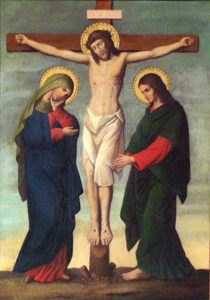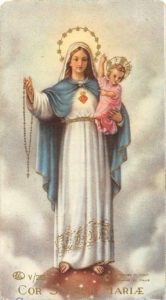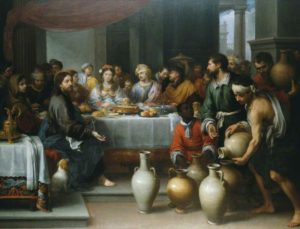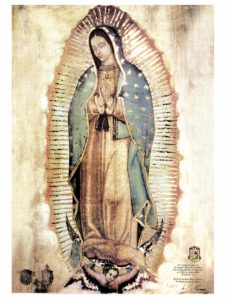About Mary – Conversation with Sr. Rita Woehlcke
As you know, my dear friend Sr. Rita is undergoing chemo for cancer, a disease she calls her “Wisdom Companion.” She has written, and continues to write, about the wisdom she is receiving as she is on this journey. You can read her essays on this blog. Just look in the search engine.
The other thing she has offered us all is that she will answer our spiritual questions. If you have a question, please read this post.
And now, let us move to the first question. This one from Richard T: “I would love to ask her, talk to her about Mary, the grace that is afforded to us through her.” Sr. Rita responds:

“Woman, behold your son.”
Since I am not a theologian, I hesitate to make any definitive statement about Mary’s place in what they call the economy of salvation. That said, I can speak about the myriad ways people are drawn to relationship with God through her. Some have found solace in that she was given to be mother to John ( and so to us) at the foot of the cross. This comes from “Woman, behold your son.’ Then he said to his disciple, ‘Behold your mother.’” (John 19:25) For the motherless child, she can be a haven. I find great joy that this woman has brought comfort, hope, and consolation to so many through the various devotions surrounding her. Many an orphaned or traumatized child created a world where they were as beloved to Mary as her own child. Stories abound of children consoling themselves with her presence – even having tea parties with her to survive being locked in a closet.

Blonde, blue-eyed Mary of the 1950s. Perfect in every way?
Personally, I could never find my way to that kind of maternal devotion. Presented to me as a child in the 50’s, Mary was portrayed as most perfect, especially gifted, chosen, sinless, — everything I wasn’t. For me she was aloof, distant, and inaccessible, preferring European kids in her apparitions at Fatima and Lourdes, not United States kids like me. (Of course, all this is bound up in what was going on for me personally in my family and faith of origin)
My capacity to welcome Mary as truly my sister and mentor on the journey of faith emerged from the teaching of Vatican II and subsequent Biblical scholarship by women theologians. She stands in the line of valiant Hebrew women risking great things for God and the fulfillment of God’s dream.
Mary holds a unique place. Her “let it be done, “echoes the “let it be” of Genesis, a new beginning for creation. I find great sympatico in her willingness to listen to the Spirit, to risk saying “Yes” with no guarantees, no triptik to map out her journey. I found myself able to pray with her in the depth of her humanity and found great consolation that just as she was given the gifts she needed, so too would God grace me for what I was called to be. Her steadfast attachment to God and God’s promise in the midst of social opprobrium and heartbreak became a source of strength. She was a woman of grit, grace made visible.
The Cana story speaks to me of Mary’s heart and the model of loving and powerful intercession.

Murillo, Bartolome Esteban; The Marriage Feast at Cana
On the third day, there was a wedding at Cana in Galilee. The mother of Jesus was there, and Jesus and his disciples had also been invited. When the wine was exhausted, the mother of Jesus said to him, “They have no wine.” Jesus responded, “Woman, what concern is this to us? My hour has not yet come.” His mother said to the servants, “Do whatever he tells you. 6 Now standing nearby there were six stone water jars, of the type used for Jewish rites of purification, each holding twenty to thirty gallons. Jesus instructed the servants, “Fill the jars with water.” When they had filled them to the brim, he ordered them, “Now draw some out and take it to the chief steward,” and they did so.
9 When the chief steward tasted the water that had become wine, he did not know where it came from, although the servants who had drawn the water knew. The chief steward called over the bridegroom and said, “Everyone serves the choice wine first, and then an inferior vintage when the guests have been drinking for a while. However, you have saved the best wine until now.”
11 Jesus performed this, the first of his signs, at Cana in Galilee, thereby revealing his glory, and his disciples believed in him. After this, he went down to Capernaum with his mother, his brethren, and his disciples, and they remained there for a few days. John 2: 1-12
She is sensitive to the couple and anticipates the possibility of their embarrassment. She simply places their situation before Jesus, saying, “ They have no wine.” She instructs the attendants, “do whatever he tells you.” She has utter confidence that his heart will be moved as hers was and that his response will be trustworthy. She recedes and makes it clear that listening to and following Jesus is the path. She teaches me always to bring the problem not my solutions to her and her son.
(For a more in depth unpacking of this scriptural moment … https://churchlifejournal.nd.edu/articles/the-riddle-at-cana-mary-and-the-biblical-mystery/ )
Of the many traditional prayers the one that speaks most to me of Mary’s essence is her Magnificat, the song she sings when visiting her cousin, Elizabeth.:
My soul proclaims your greatness, O God!
and my spirit has rejoiced in you, my Savior,
For your regard has blessed me
Poor and a serving woman.
From this day all generations
will call me blessed,
For you who are mighty, have made me great.
Most holy be your Name.
Your mercy is on those who fear you
Throughout all generations.
You have shown strength with your arm,
You have scattered the proud in their hearts’ fantasy.
You have put down the mighty from their seat.
And have lifted the powerless.
You have filled the hungry with good things,
and have sent the rich away empty.
You remembering your mercy,
have helped your people, Israel.
As you promised Abraham and Sarah
Mercy to their children forever.
It celebrates who she knows herself to be, who she knows God to be. She freely makes her humanity totally available to God. She welcomes the child she and her people have always longed for. She echoes the canticles of the Hebrew women in whose lineage she stands – brave women risking themselves for the good of the people and trusting when trust seems absurd.
The apparition that does speak to me is our Lady of Guadalupe — the dark-skinned Madonna, reminiscent of the many black virgin statues of Europe. She is the one who chooses Juan Diego a 57-year old Aztec convert rather than the conquering Spanish leaders and church hierarchy. R Vincent Gartland writes:
 The Virgin of Guadalupe has deep meaning for all. She is a synthesis of all that had been lost to the indigenous people through the Spanish conquest. Her portrait on Juan Diego’s mantle was a picture writing which all Indians, regardless of their language, could understand for it was deeply rooted in their rich heritage. The Virgin’s face was not that of a specific tribe, but contained the features of the Spanish-Indian Mestizo representing the unity of the two races that had been completely separated by the Spanish conquest. Her mantle contained symbols from the Aztec calendar representing the union of heaven and earth. The Eagle at her feet, the sun, the brilliant rays, flowers and music, and her appearance on a mountain were all pregnant with meaning for the native people. In fact, the image of the Virgin left on Juan Diego’s crude cactus fiber cloak contained many ancient symbols so important to the Aztec religion. This helped to restore many of the values and sense of pride lost to the Indian people in the conquest.
The Virgin of Guadalupe has deep meaning for all. She is a synthesis of all that had been lost to the indigenous people through the Spanish conquest. Her portrait on Juan Diego’s mantle was a picture writing which all Indians, regardless of their language, could understand for it was deeply rooted in their rich heritage. The Virgin’s face was not that of a specific tribe, but contained the features of the Spanish-Indian Mestizo representing the unity of the two races that had been completely separated by the Spanish conquest. Her mantle contained symbols from the Aztec calendar representing the union of heaven and earth. The Eagle at her feet, the sun, the brilliant rays, flowers and music, and her appearance on a mountain were all pregnant with meaning for the native people. In fact, the image of the Virgin left on Juan Diego’s crude cactus fiber cloak contained many ancient symbols so important to the Aztec religion. This helped to restore many of the values and sense of pride lost to the Indian people in the conquest.
Our Lady of Guadalupe restored dignity and pride to the poor and broken people. In her dialogue with Juan Diego she used the familiar form of the language, the language spoken among equals among family members. The Spanish conquerors, in order to evangelize the conquered people, destroyed their temples and took away their cultural heritage. The Virgin of Guadalupe used this persecuted culture to speak to the entire world. “I am mother for you and for all,” she said to Juan Diego.
The universal message of Guadalupe is to go to the poor, to be open to being evangelized by the poor, the oppressed, the broken, to hear and remedy their sorrows, laments, miseries, and pains not only in Mexico or Latin America but wherever oppressed people are found. Our Lady of Guadalupe calls us to commit to hear and to see the cry of the poor.
The Virgin could have gone directly to the Bishop if she only wanted a Church. It would have been easier, but she chose to use a poor Indian, Juan Diego, and sent him to evangelize the bishop and the Spanish clergy — the ones who felt they already had all the truth. The request for a church was simply a way of giving love and compassion, help and protection to the least of God’s people. She asked for a Church, not to preach, but to hear the sorry, the suffering, and the cry of the poor. By choosing Juan Diego, Mary restored dignity and hope to native people who had been dehumanized by foreign oppression. . . . In every age, the story of Guadalupe should remind the Church that those the Church alienates may be the ones who have the gifts the Church needs so badly to grow and reform.
So yes, I believe many graces flow from Mary of Nazareth, the fierce kind that challenge me to live more deeply, more broadly, that kind of steadfast love and fidelity .
Great reads on the subject: Elizabeth Johnson’s Truly Our Sister and Dangerous Memories.
And for more on the Black Virgin check out China Galland, The Power of the Dark Feminine
Thanks to Sr. Rita for this. There’s much to think about here.
I have a slightly different relationship with Mary, and have come to know her in her Black Madonna, Lady of Sorrows aspect. I’ll write a bit about that in the next few days.
Thank you so very much for this very thoughtful and profoundly meaningful response. Recently, I watched “Pope Francis: A Man of His Word.” Therein the Holy Father calls the Church to recomit its obligation to stand alongside the poor, to make the poor its central focus. Thank you, Sr. Rita
Thanks so much for your comment, Richard.
Thanks Lauren and Sr Rita. 🙏
Thanks Lauren for hosting this interesting series of posts featuring Sister Rita. It’s so engaging to see how Sister Rita faced challenges of faith and still found her way to a meaningful relationship with God.
Francesca
You’re very welcome Francesca. I’m glad you’re finding it useful.